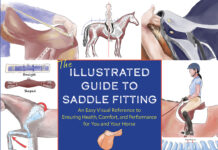When a horse loses confidence, the most important thing to do is retreat.
Retreat from…
- The threshold
- The obstacle
- The maneuver
- The objective
Fear intensifies when you “approach” and reduces when you “retreat.” Loss of confidence is the first phase of fear, so if you can prevent the loss of confidence, you reduce fear.
How to Retreat
Other words for retreat would be:
- Back off
- Back away
- Move away
- Withdraw
- Give ground
- Leave
So how do you apply this to your horse?
- When he hesitates, back off. Wait, or move away.
- When he has trouble with you, withdraw, back away, move away or leave altogether.
- If he has trouble approaching you, back away and keep backing while drawing him toward you at the end of the 12- or 22-foot line.
- When he has trouble with an obstacle, give ground—move away from it. Move away as far as necessary but keep his nose pointed toward it. Make widening circles around it or simply drift away. (Turning directly away may cause the horse to spook and run, so keeping his nose tipped toward it is a good safety tip.)
- When he has trouble with a maneuver, back off. Most people want to keep doing more of it, but it’s better to back off and then try again when the horse is in the right frame of mind. When he has trouble with something you are doing “to” him (such as clipping, wanting to touch is ears, hind legs, et cetera), move toward it and then away from it. Toward, then away, toward, away, further toward, away, et cetera, until finally he’s confident enough to allow you to go all the way.
As you retreat, the horse gets calmer, and then you can re-approach. But do not approach until the horse is calmer or it will get worse. And all of a sudden for no reason at all, your horse will blow up or quit—today, tomorrow or months from now. Most people don’t see it coming, but now you will.
The more you push a horse over his confidence thresholds, the more unconfident you make him. But as you feel your horse approaching a threshold and retreat from it, then retreat and re-approach as many times as necessary. All of a sudden, the thresholds reduce and even disappear altogether. Mastery would mean knowing the thresholds before your horse felt them.
How Far to Retreat
How far to retreat depends on how afraid the horse is. If it’s just a hesitation, then waiting on the spot until the horse relaxes and can move on is all it will take. But if the horse is really afraid, overreacting, frantic, then you need to move away as far as necessary until the horse can relax.
Here’s an example for you:
Many people have horses that are “barn sour.” (We think they should be called barn sweet, because they actually want to be at the barn rather than with the human, or with another horse, or at the gate, et cetera.) Typically the horse is saddled up, mounted and ridden directly away from the barn. The horse starts to hesitate, but the rider urges him on. Then the horse gets more reluctant and the rider pushes harder and spanks him. The horse goes forward again but suddenly spooks at something. He whirls around and gallops back to the barn, with or without his rider!
Is the spooky thing what caused it? If you guessed “no,” you are right. The horse demonstrated his first loss of confidence way back at the first threshold, and instead of retreating, the rider pushed him over it. The next threshold got bigger, and the rider pushed him over that one too. There was no next threshold. It was a logical consequence—logical if you understand prey animals, that is. By that time, the horse had completely lost trust and confidence in his leader, was really scared and overreacted because adrenaline was coursing through his veins. He did what every self-respecting prey animal should do: save himself, run for his life! And, don’t trust the human next time.
The right thing to do is respect the threshold by waiting or retreating, depending on how big it is, then keep retreating and re-approaching until the horse volunteers to cross it. Do the same with the next one, and the next, and the next. Pretty soon there is no next. The horse starts to realize he can trust you not to throw him over the cliff and push him when he’s unsure. Progressively he’ll trust you more and go wherever you suggest, knowing that if he has trouble, you will sort it out before going on. In the end, it’s all about how self-confident he is and how confident he is in you, about how much trust exists in the relationship between you (the leader) and your horse (your follower).
Further Reading
Parelli Natural Horsemanship: The Seven Games





